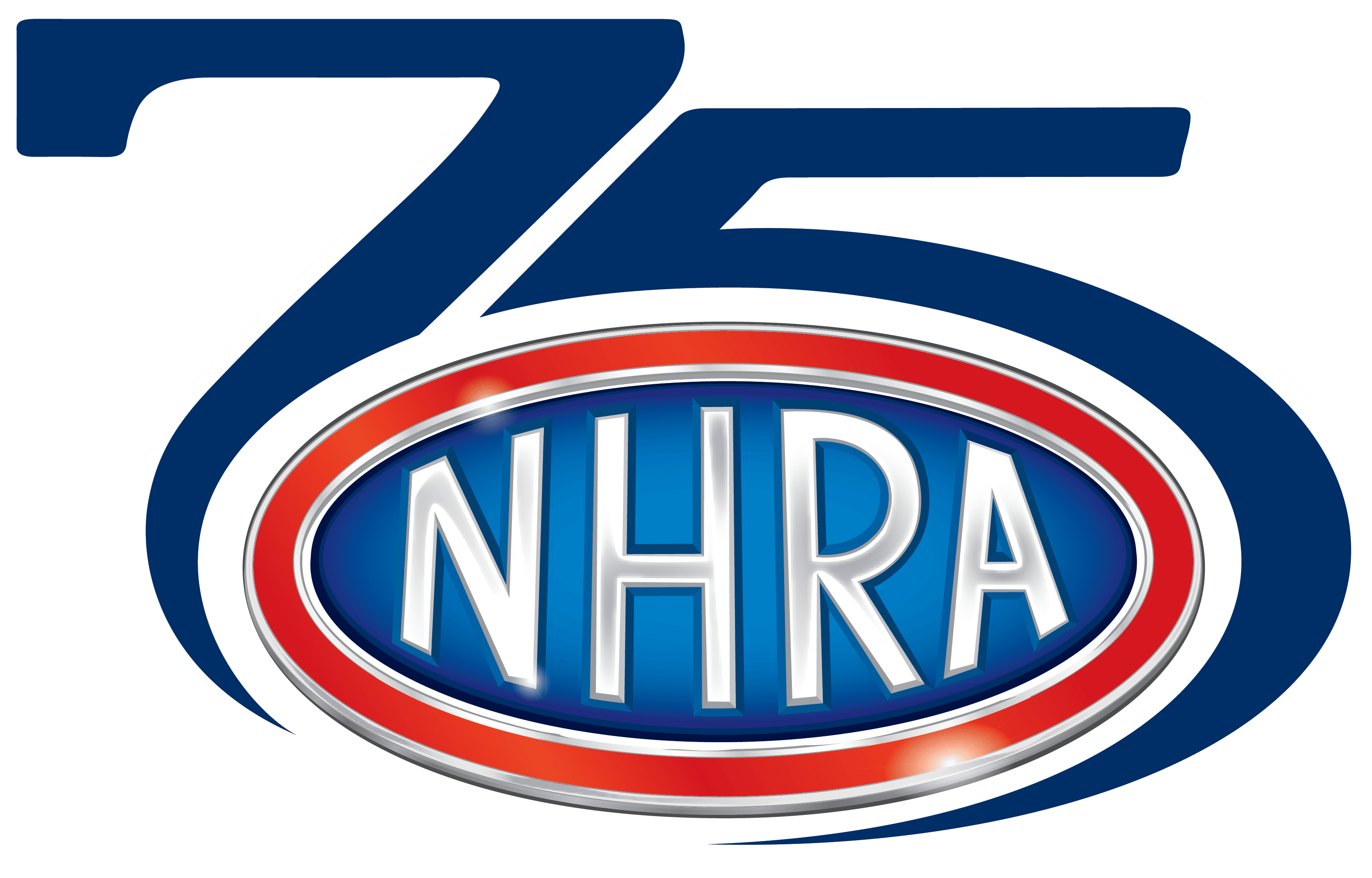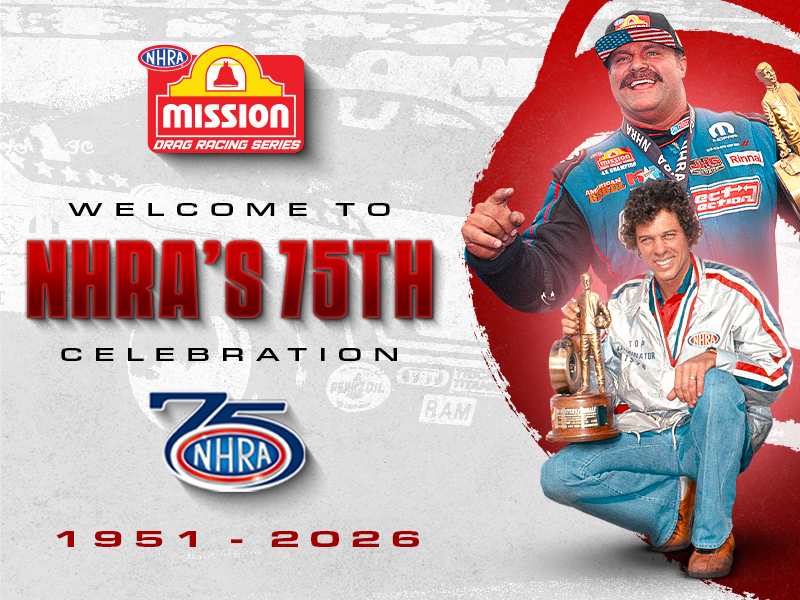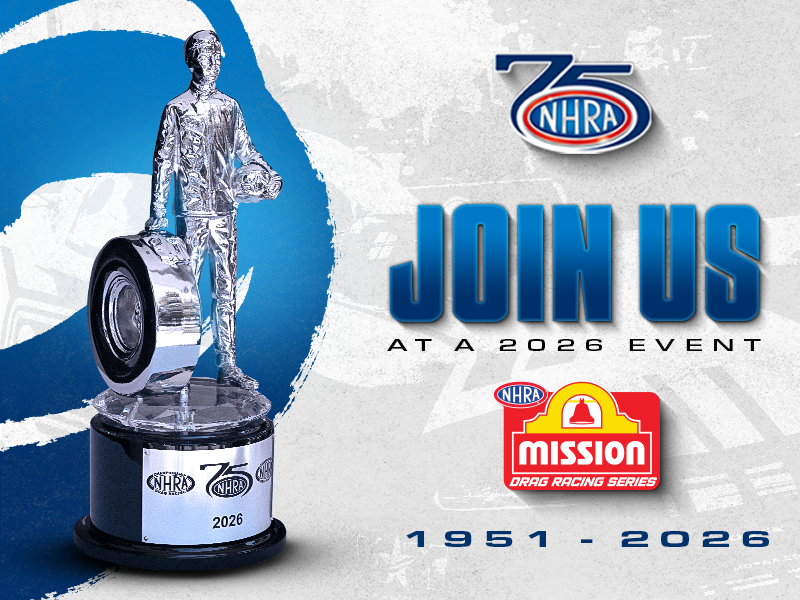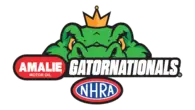All that glitters is not Greek
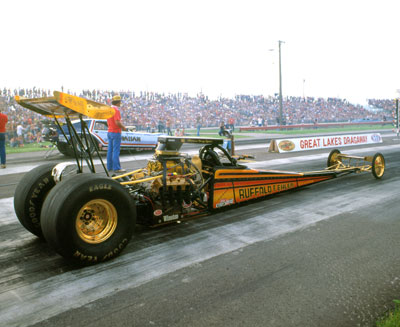
Steve Reyes
|
It didn’t take long after Friday’s column about “the Golden Greek’s” gold-plated ride to hit the virtual presses before folks started reminding me that Chris Karamesines wasn’t the only one to adorn his Top Fueler with the precious metal. A few years after “the Greek’s” dragster, the Kenosha, Wis.-based team of Tony Ruffalo and John Ehlen had a Top Fueler that by all accounts was even more spectacular and certainly much different than Karamesines’ car.
Finding Ruffalo proved not difficult at all as there still was an Internet listing for the used-car business that he and Ehlen had owned, and Ruffalo’s memory was tack-sharp about the car and all that went into it.
The car was novel beyond its gold jewelry – which I’ll certainly get to – most notably in its construction. Dennis Rollain, who had partnered with Lil' John Buttera on the famed R&B chassis plant in Wisconsin, built the car, which was superlight (200 pounds under minimum weight) and featured a bulkhead design with stressed side skins. "Other than the roll cage, there wasn’t a bent tube on the car,” he said. “All of the tubes were straight-pinned into seven bulkheads. It was way ahead of its time and completely different than any other car out there.”
As you can see in the photo above, the car also had an injector scoop funneling air from atop the roll cage; what you can’t see is the inside of the cockpit, which sported a couple of unique features. The dashboard was equipped with switches to control the fuel and ignition as well as parachute deployment.
“Everything on the car was user-friendly,” said Ruffalo, who with Ehlen had campaigned in Super Stock. “I told Dennis that I was new to the [Top Fuel] game and didn’t want to fumble for something on the roll cage and miss or if I didn’t have time to do it. The car also had what we called a ‘heel shifter,’ which was a third pedal between the throttle and the clutch. Air shifters at that time were very inconsistent, so we created this. Once I slipped my foot on the clutch, I rested it on what looked like a brake arm; you just pushed your heel forward, and it positively shifted the car every time. You could also use it to prop your body up on it too when you pulled the chutes; it really saved your shoulders.”
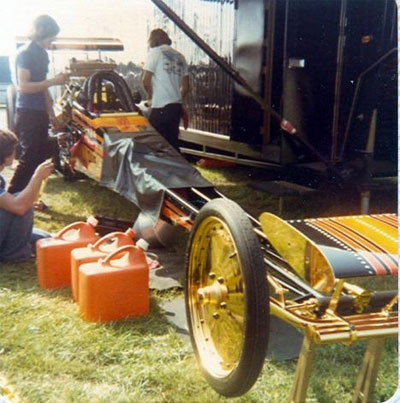
John Kilburg
|
What’s also very evident in the photos is the amount of gold applied to the car. As on Karamesines’ car, the gold was applied at Precision Plating in Chicago, where Funny Car racer Reno Nannini (of Fontanini & Nannini fame) worked. Ruffalo estimated that there was about $30,000 worth of 24-karat gold plating on his car, not only visible in all of the conspicuous places such as the blower, wheels, wing struts, and so forth, but also covering every piece of linkage, the seat, and even the weight bar. Not only that, the gold was thick, up to 7-mil(about 1/32-inch).
“There was nothing that we could unbolt that wasn’t plated,” testified Ruffalo. “I think that the entire [gold-plating] effort probably cost $50,000 to $60,000. Because everything had to be hand-polished first, there was a lot of effort on some of the tricky hand-formed aluminum pieces, and the rims were so deep that JP Plating – which did the polishing and nickel plating – had to make custom fixtures for them. Then we had everything clear epoxied and baked on so nitro wouldn’t attack the gold. We were writing checks left and right. We also had a lot of gold on the truck and trailer.”
The two were in their mid-20s when all of this was going on, begging the obvious questions: How and why?
“We both worked our butts off to raise the money,” he recalled. “John was working two jobs, and I was working then for American Motors. We ran the car a lot and put every penny we could scrape up or earn right back into it. We broke our backs putting together a beautiful dragster that ran fast trying to attract a sponsor. We came close to AMC money at one time, but they went with an off-road team instead and got nothing in return. We could have given them 300 percent of our bodies.”

Even the team's push truck -- shown doing Don Garlits push-starting duty at last year's Gatornationals -- was adorned with gold plating.
|
Although the team subsisted mostly on match race action, the car ran well enough to qualify at the select national events it attended. Highlights included the team's first five-second run at home state track Great Lakes Dragaway in 1981, breaking Don Garlits’ track speed record in St. Louis, and a career-best 5.79.
“It’s a shame we never attracted the big money because I think we could have done rather well,” he said. “We had some real good help from guys like Marc Danekas and Marvin Graham – Marc took us under his wing and helped us with tuning – and from the Candies & Hughes team and [Mark] Oswald, who would give us parts and pieces – complete piston and rod assemblies – and tell us we could pay them whatever we could afford down the road.”
The team finally parked the car after its 1984 season. “At the start of 1985, we looked at each other and realized we couldn’t sell our souls any further and knew it was time to park it,” he said. “The car is in Garlits' museum in Florida, and so is the [push] truck, and I’m working on the trailer so he can have a whole display."

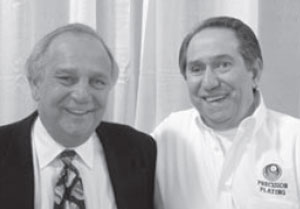
Reno Nannini, right, with Jim Belmonti
|
Believe it or not, Nannini worked fulltime until just recently at Precision Plating, where he had risen to the lofty position of vice president of research and development, not bad for a guy who started out there in the early 1970s doing building maintenance.
Nannini’s story is pretty remarkable: He left his native Italy to join his grandparents in the United States in 1952 at age 14, knowing not a word of English. On his uncles’ advice, he went to bricklaying school and became a bricklayer/stone mason.
When he became interested in cars, he teamed up with Fontanini in the mid-1960s on Plymouth Barracuda and Dodge Charger injected nitro Funny Cars that were among the quickest in the Midwest, and it was through racing that he met Precision’s plant manager (and eventually its owner and CEO) Jim Belmonti. When Precision was having problems with its bricklaying contractor at its new facility, Belmonti called on his friend to help. That led to seasonal building maintenance and mechanical work at the plant and eventually to a full-time job. In 1971, he promised them six months but never left and was responsible for assembling all of the tanks and doing all of the plumbing in the company’s newest location. (You can read an interesting history of Precision Plating here, in a document they created in 2004 to celebrate the company's 100th anniversary.)
I have a call out to Reno, hoping for a return, to verify some of the confusing and conflicting information about “the Greek’s” car. Stay tuned.


Norman Blake
|
I heard from quite a few people who witnessed Karamesines' crash of the first gold-plated car at the 1975 Gatornationals, including pal Wade Nunnely, who has contributed stories and photos here several times.
“I was high up in the pitside stands at about the 1,000-foot mark,” he recalled. “I distinctly remember a green haze above the engine just after the launch. I'd never seen anything like this, either before or since. As the car came downtrack, the rear end started to wiggle back and forth, gradually swinging wider and wider. When it got to where I was, the car started to rock from one slick to the other. Mind you, Karamesines still has his foot to the floor! Then it rocked over to the right, and the front end rotated to the left and went into the guardrail in at least a 45-degree angle. The front end hopped over the rail and slid up until the cockpit was right on the knife edge of the rail. The car did a couple of rolls as it slid along the rail, then jumped in the air and landed upside down on top of the guardrail!
“It slid along, perfectly balanced, for about 100 feet, then the rear half fell back onto the track. It rolled a couple more times, the front came off the rail, and the car started sliding down the shutoff area upside down. After a couple of hundred feet, it went off the left side of the track into the grass and started snap-rolling violently, pieces flying into the air before it finally came to rest! I was stunned and remember thinking that I had just seen ‘the Greek's’ death. It seemed like an eternity before the announcer said that ‘the Greek’ was out of the car and apparently OK. In fact, in a few minutes, they said that Chris had taken off in a four-wheeler to go get his truck so he could start picking up the gold-plated parts. The next day, they did say that he had sustained a knee injury during the crash.
“All these years, I have thought that the green haze had been oil coming out of the engine and that it had gotten on the slicks and caused all the gyrations that led to the crash. I can see in the picture of the crash that it does look like the left slick is flat, but this photo was taken after the car had come back down off the top of the guardrail, which could easily have cut the tire. So I'm going to stick with my feeble memory until someone can prove me wrong.”
